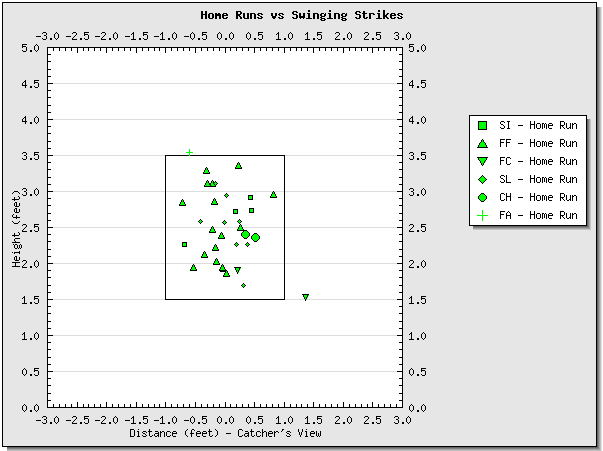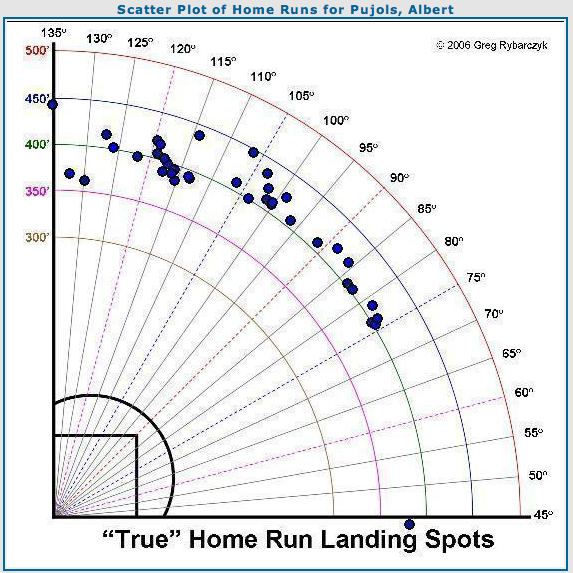
| Baseball Beat | September 14, 2010 |
Joey Votto slugged his 34th home run last night as the Cincinnati Reds pummeled Barry Enright and the Arizona Diamondbacks, 7-2. His dinger was overshadowed by the fact that Jay Bruce jacked two homers in his first two trips to the plate after missing a dozen games. Nonetheless, Votto's four bagger was his Major League Baseball-leading 17th HR to the opposite field according to play-by-play announcer Thom Brennaman.
I happened to be watching the game at that moment and made a note to check Votto's scatter plot on Hit Tracker, which logs and calculates the trajectory and distance of every home run in Major League Baseball. As it turns out, Greg Rybarczyk's site indicates that Votto has produced 19 homers to the left of straightaway center field (including yesterday's big fly, which isn't part of the following graph).

As shown, Votto has clubbed a couple of home runs just to the left of the 90° mark. My guess is that these bombs (one of which traveled 457 feet, the 24th-longest HR in 2010) were not deemed to be opposite field by MLB. The monster blast was deposited onto the party deck in center field at Great American Park, a first for Brewers' color analyst Bill Shroeder.
After looking at the distribution of Votto's home runs, I began to think about the pitch locations, especially those that were hit to the opposite field. Without the ability to create graphs like our own Dave Allen, I resorted to Joe Lefkowitz's PitchF/X Tool. Interestingly, all but four of Votto's long balls were turned around on pitches in the middle 60% of the strike zone. Yesterday's homer was on the pitch designated as a sinker on the outer 20% of the chart. Gameday described it as an 88-mph sinker.

By the way, Joe's site allows you to screen Votto's home runs for velocity (he has slugged three HR on 95-mph fast balls and two on 78-mph sliders at the other end of the spectrum), horizontal and vertical movements, and release points. If you have a cool boss or time on the weekend, click on the PitchF/X link in the banner at the top and play around with all the variables, including choosing a pitcher, batter, team, stadium, home plate umpire, plate discipline, pitch type, result, batted balls, count, pitch count, velocity, runners on base, and much more. It's a treasure chest full of information and fun.
Combining video with sites such as Hit Tracker and Joe Lefkowitz's PitchF/X Tool (among others) can help turn you into a baseball analyst or perhaps even an amateur scout in no time. Want to contemplate how to position fielders and pitch to Jose Bautista and Albert Pujols, the respective home run leaders in the AL and NL? Check out their scatter plots.


The pull hitter on the left is Bautista. The Toronto Blue Jays slugger has yet to hit a home run to the right of center field. In fact, he has only slugged about a half dozen to the middle third of the field. The other 40 or so homers have been launched to left field with more than half of those sailing over the fence between the left fielder and the foul line. Pujols, on the other hand, has tremendous power to center field, as exhibited by the fact that nearly half of his home runs have been hit to the middle third of the field. Interestingly, the three-time MVP has failed to slug a home run to the right third of the field.
Sometimes you just let the picture speak for itself.
Have fun and make sure that you don't miss lunch today.
Note: Jeremy Greenhouse's innovative Batted Ball Location Leaderboards are also valuable tools in this area.
Comments
Excellent work, rich. Votto's willingness to go opposite field is similar to Stan Musial, but with more power.
Posted by: Al Doyle at September 14, 2010 9:02 AM
Hey, isn't that a home run down the right field line for Pujols? The black dot just above the "g" in "Landing"?
Posted by: Nathaniel Dawson at September 16, 2010 5:05 PM